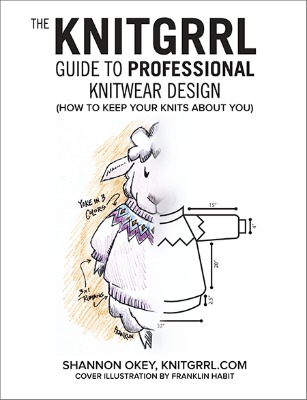This post contains affiliate links.
Today, I finished reading Shannon Okey’s The Knitgrrl Guide to Professional Knitwear Design.
The book is a primer for getting started as a (hand) knitting or crochet designer. It addresses the business end of designing (e.g., writing up, testing, printing, marketing patterns) and is not a guide on how to design. Shannon compiles information from her own career; from extensive interviews with designers, editors, tech editors, publishers, and others in the industry; and from a range of web resources into an easily digestible package. Her writing style is both conversational and professional. The book provides many links to further reading on the internet.
The first section of the book discusses different aspects of being a professional designer. Shannon shares her own opinions and also seeks out tips from others in the industry. The chapters in this section are:
- What does it mean to be professional?
- Social media
- TCB, No PB&J Required, or: The Business Side of Things
- Send in the lawyers
- Writing patterns
- Making sales
- Proposals and Publishing
- Advertising
- Further education
- Professional organizations and associations
- Standing out
The main themes Shannon emphasizes in this section are behaving professionally, promoting yourself and your brand/business, understanding your strengths and limitations (and therefore how and when to get help), and staying true to your own values. For example, is it more important to you that you have full control over your patterns or would you prefer to design while others deal with photography, distribution, and/or tech editing? While she clearly presents her own opinions, Shannon makes it clear that people can find success through many different paths so you will need to find what works for you.
This section is slightly more than half of the book. Shannon doesn’t claim to have invented the wheel, and much of this information is freely available online – she even provides links for you. You will probably consider this part of the book successful if you believe that:
- as an emerging designer from outside of the industry, it would take you more time/money to gather this information on your own than to buy and read Shannon’s book,
- Shannon Okey as a success in the industry, and
- you can trust Shannon and thereby, her advice.
On the other hand, if you feel like Shannon is just building up her “cult of personality” through this book, or that she hasn’t enjoyed the type of success you envision for yourself, or you are already aware of the many resources she includes in the book, then you may feel cheated. As a recent knitter, I am not as familiar with Shannon Okey (gasp!) as I am with many of the crochet designers profiled in the next section, so I started the book without a bias towards or against her. I did, however, play the mental game of wondering how I would have responded to the same material if it was presented by Crochet Designer X or Crochet Designer Y, and I know my response may have been different if another author presented the same information.
The second section of the book, The interviews, includes profiles of over 30 professionals with various roles and tenure within the industry. The consistent messages in this section are about remaining professional and realizing that this is an industry where you are expected to work hard and long hours but may not reap financial rewards in proportion to those efforts. The interesting thing about this section is that, because so many voices are “speaking,” there are many different messages. In a sense, this section reinforces the early point about staying true to your own values. I found the interviews fascinating – the “horror stories” in particular are real learning lessons.
The final section of the book includes two appendices (book proposal and class listing templates) and yet more links to various resources.
I would recommend this book to an aspiring/emerging crochet/knit designer. I personally had the benefit of a fabulous mentor, Mary Nolfi, through the Crochet Guild of America‘s mentoring program, and I still learned a lot from reading The Knitgrrl Guide to Professional Knitwear Design. Yes, the information presented in the book exists out there in the world, but if you don’t have it at your fingertips during the early stages of your career, you might make devastating mistakes. With that said, I do have some complaints about the book. In the second section, the editing changes. Sentences suddenly end without periods, or even mid-thought. It isn’t clear to me if this is because the interviews were conducted online and Shannon is keeping them in the original, grammatically incorrect format, or…? I also had some issues with the formatting of the book in general. There are more blank pages than I’m accustomed to seeing. In the interview section, there are many parts where it seems like a page break was incorrectly inserted or removed. These weren’t deal breakers for me, but contrast with Shannon’s presentation of herself as a detail-oriented self-publisher. It would have been helpful to include a short chapter, or at least some discussion, about damage control if you’ve made mistakes early in your career (i.e., before reading this book) since there is a lot of talk about people who behave unprofessionally or act like divas.


